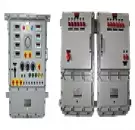Description/ Specification of Erection & Commissioning of Switchgears
The process of erection and commissioning of switchgears involves intricate technical procedures and systematic protocols to ensure the safe and efficient functioning of electrical systems. Switchgears play a critical role in power distribution and protection, making the erection and commissioning process a crucial phase in the overall setup. Erection and installation of switchgears begin with meticulous planning and site preparation. A team of skilled technicians and engineers assesses the site to ensure it meets the required specifications for the installation. This includes verifying the structural integrity of the area, confirming the appropriate space for the switchgear, and assessing the proximity to power sources. During the erection phase, precise alignment and positioning of the switchgear components are crucial to ensure proper functioning and easy access for maintenance. Proper anchoring and alignment with respect to the electrical system are essential for stable and secure installation. Commissioning, on the other hand, marks the critical phase where the installed switchgear is put into operation. It involves a series of tests and evaluations to ascertain the performance, functionality, and safety of the switchgear under various operating conditions. The commissioning process typically includes a series of diagnostic tests, insulation tests, and functional checks to validate the efficiency of the installed switchgear. Engineers and technicians meticulously verify the proper wiring, connections, and operational controls, ensuring that all components are seamlessly integrated and operating as per the specified standards and requirements. During the commissioning phase, safety protocols are of paramount importance. Strict adherence to safety regulations and guidelines is essential to prevent potential hazards, ensuring the protection of personnel and equipment. Comprehensive checks for insulation integrity, proper grounding, and functionality of protection devices are carried out to minimize the risk of electrical faults and ensure a secure operating environment. Furthermore, post-commissioning documentation and training are provided to the concerned personnel to ensure the effective operation and maintenance of the switchgear. Detailed records of the commissioning process, including test results, operation manuals, and safety instructions, are compiled for future reference. Additionally, comprehensive training sessions are conducted to familiarize the maintenance staff with the operation, troubleshooting, and routine maintenance of the switchgear, enhancing their competency and ensuring the continuous optimal performance of the electrical system. In conclusion, the process of erection and commissioning of switchgears is a meticulous and systematic procedure that requires careful planning, precise execution, and thorough testing to ensure the reliable and safe operation of the electrical system. Strict adherence to safety protocols and comprehensive documentation are key aspects of this process, ensuring the longevity and efficiency of the installed switchgear.
Erection & Commissioning of Switchgears
The process of erection and commissioning of switchgears involves intricate technical procedures and systematic protocols to ensure the safe and efficient functioning of electrical systems. Switchgears play a critical role in power distribution and protection, making the erection and commissioning process a crucial phase in the overall setup. Erection and installation of switchgears begin with meticulous planning and site preparation. A team of skilled technicians and engineers assesses the site to ensure it meets the required specifications for the installation. This includes verifying the structural integrity of the area, confirming the appropriate space for the switchgear, and assessing the proximity to power sources. During the erection phase, precise alignment and positioning of the switchgear components are crucial to ensure proper functioning and easy access for maintenance. Proper anchoring and alignment with respect to the electrical system are essential for stable and secure installation. Commissioning, on the other hand, marks the critical phase where the installed switchgear is put into operation. It involves a series of tests and evaluations to ascertain the performance, functionality, and safety of the switchgear under various operating conditions. The commissioning process typically includes a series of diagnostic tests, insulation tests, and functional checks to validate the efficiency of the installed switchgear. Engineers and technicians meticulously verify the proper wiring, connections, and operational controls, ensuring that all components are seamlessly integrated and operating as per the specified standards and requirements. During the commissioning phase, safety protocols are of paramount importance. Strict adherence to safety regulations and guidelines is essential to prevent potential hazards, ensuring the protection of personnel and equipment. Comprehensive checks for insulation integrity, proper grounding, and functionality of protection devices are carried out to minimize the risk of electrical faults and ensure a secure operating environment. Furthermore, post-commissioning documentation and training are provided to the concerned personnel to ensure the effective operation and maintenance of the switchgear. Detailed records of the commissioning process, including test results, operation manuals, and safety instructions, are compiled for future reference. Additionally, comprehensive training sessions are conducted to familiarize the maintenance staff with the operation, troubleshooting, and routine maintenance of the switchgear, enhancing their competency and ensuring the continuous optimal performance of the electrical system. In conclusion, the process of erection and commissioning of switchgears is a meticulous and systematic procedure that requires careful planning, precise execution, and thorough testing to ensure the reliable and safe operation of the electrical system. Strict adherence to safety protocols and comprehensive documentation are key aspects of this process, ensuring the longevity and efficiency of the installed switchgear.
